Abstract
A murine immunoglobulin G monoclonal antibody (MAb) raised against outer membrane vesicles of Moraxella catarrhalis 035E was shown to bind to a surface-exposed epitope of a major outer membrane protein of this organism. This outer membrane protein, which had an apparent molecular weight of approximately 80,000 in sodium dodecyl sulfate-polyacrylamide gels, was designated CopB. MAb 10F3, reactive with CopB, bound to a majority (70%) of M. catarrhalis strains tested. More importantly, mice passively immunized with MAb 10F3 exhibited an enhanced ability to clear a bolus challenge of M. catarrhalis from their lungs, a result which suggested that CopB might have potential as a vaccine candidate. The M. catarrhalis gene encoding CopB was cloned in Escherichia coli, and nucleotide sequence analysis of the copB gene indicated that the CopB protein was synthesized with a leader peptide, a finding confirmed by N-terminal amino acid sequence analysis of the mature CopB protein purified from M. catarrhalis 035E. Southern blot analysis showed that chromosomal DNA from seven different M. catarrhalis strains hybridized with a probe comprising the majority of the copB structural gene from strain 035E. Additional data emphasizing the extent of conservation of the CopB protein among M. catarrhalis strains were obtained from Western immunoblot analyses with polyclonal antisera raised against CopB proteins from different M. catarrhalis strains used to probe the recombinant form of the CopB protein from strain 035E. The ability of the CopB protein to function as a target for biologically active antibodies and its apparent conservation among M. catarrhalis strains warrant further investigation of this outer membrane protein as a potential vaccine candidate.
Full text
PDF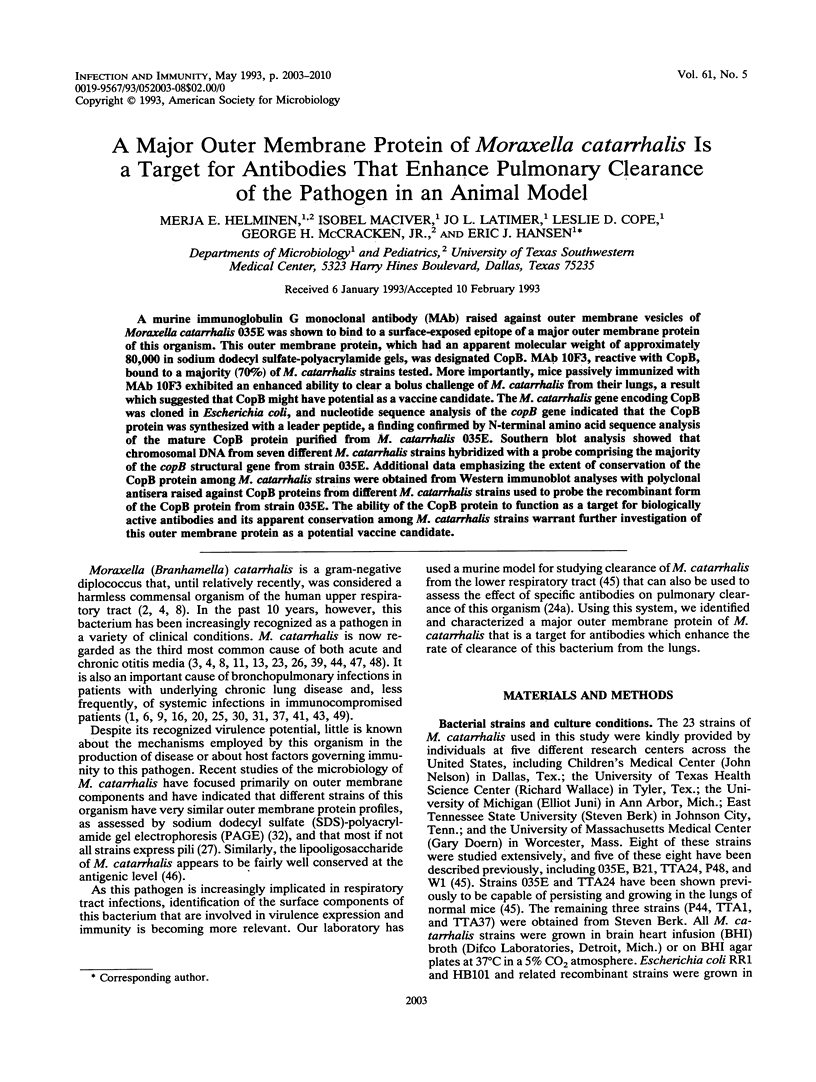

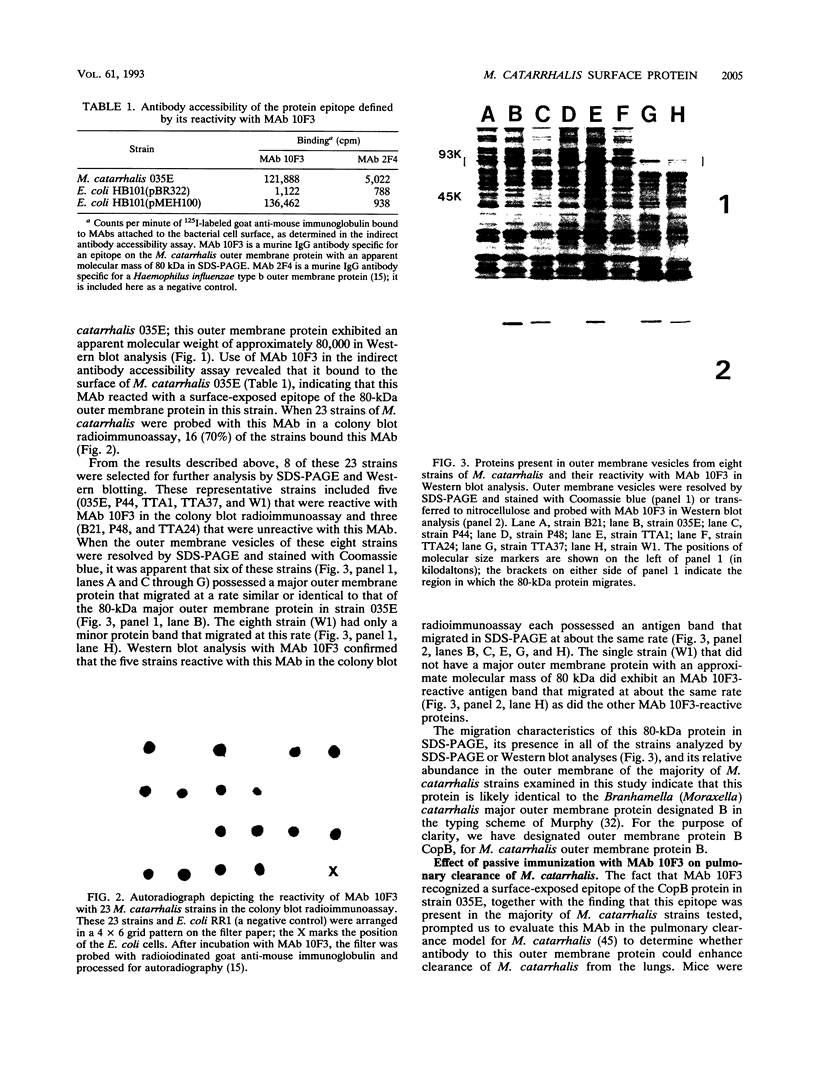

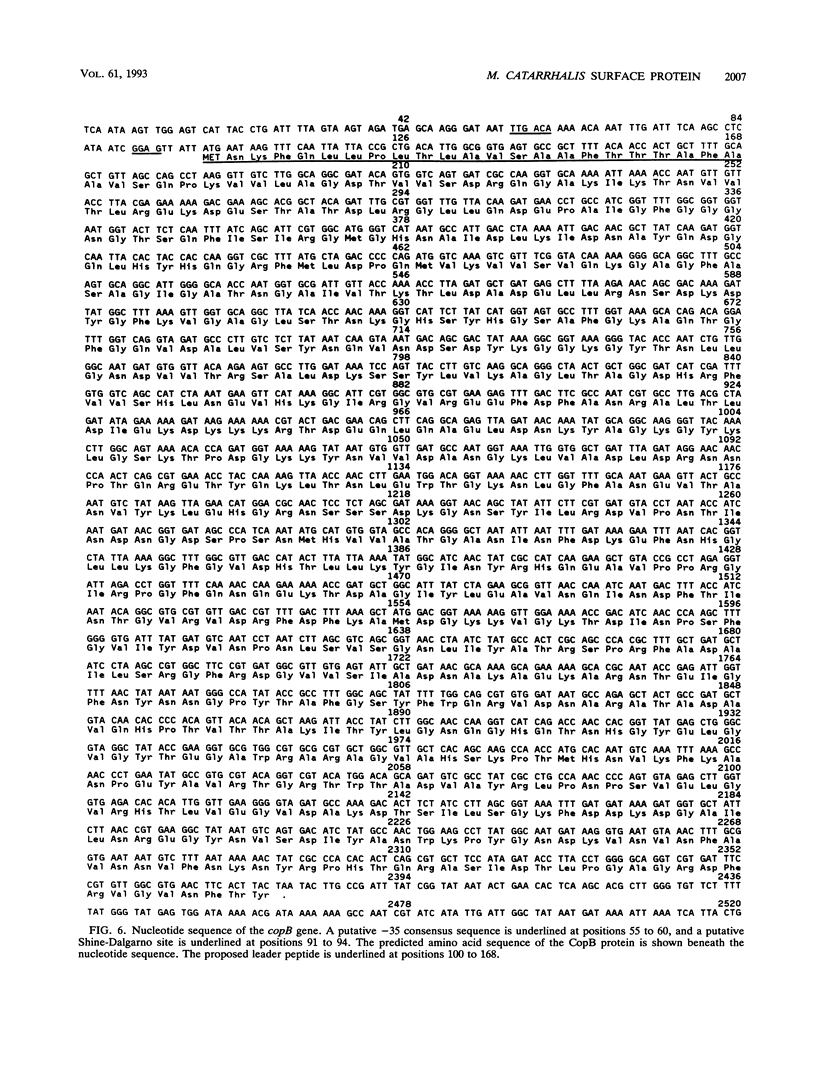
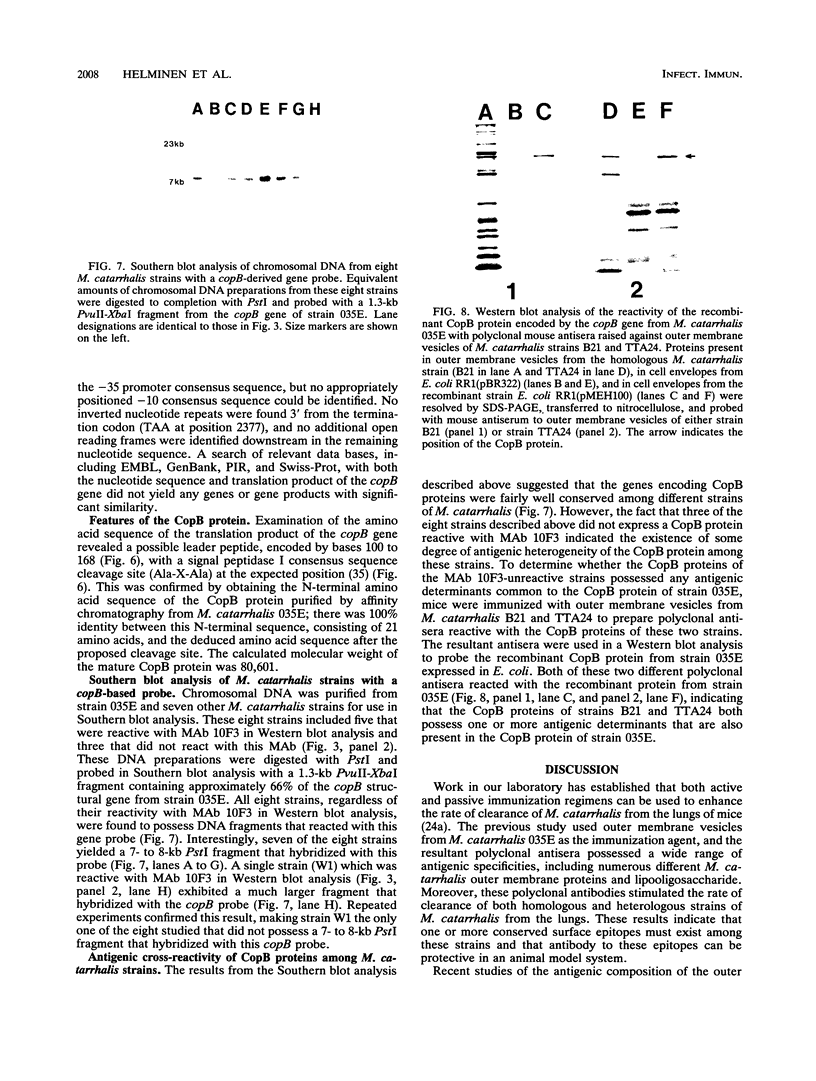
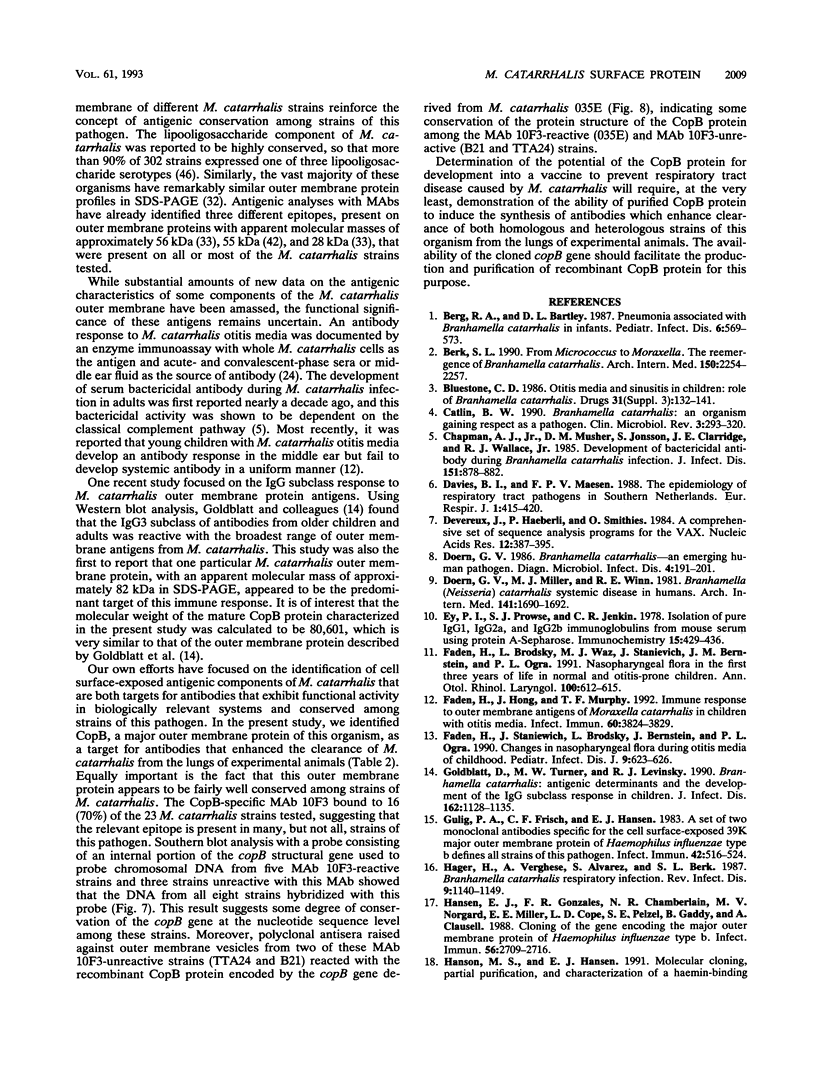

Images in this article
Selected References
These references are in PubMed. This may not be the complete list of references from this article.
- Berg R. A., Bartley D. L. Pneumonia associated with Branhamella catarrhalis in infants. Pediatr Infect Dis J. 1987 Jun;6(6):569–573. doi: 10.1097/00006454-198706000-00017. [DOI] [PubMed] [Google Scholar]
- Berk S. L. From Micrococcus to Moraxella. The reemergence of Branhamella catarrhalis. Arch Intern Med. 1990 Nov;150(11):2254–2257. [PubMed] [Google Scholar]
- Bluestone C. D. Otitis media and sinusitis in children. Role of Branhamella catarrhalis. Drugs. 1986;31 (Suppl 3):132–141. doi: 10.2165/00003495-198600313-00029. [DOI] [PubMed] [Google Scholar]
- Catlin B. W. Branhamella catarrhalis: an organism gaining respect as a pathogen. Clin Microbiol Rev. 1990 Oct;3(4):293–320. doi: 10.1128/cmr.3.4.293. [DOI] [PMC free article] [PubMed] [Google Scholar]
- Chapman A. J., Jr, Musher D. M., Jonsson S., Clarridge J. E., Wallace R. J., Jr Development of bactericidal antibody during Branhamella catarrhalis infection. J Infect Dis. 1985 May;151(5):878–882. doi: 10.1093/infdis/151.5.878. [DOI] [PubMed] [Google Scholar]
- Davies B. I., Maesen F. P. The epidemiology of respiratory tract pathogens in southern Netherlands. Eur Respir J. 1988 May;1(5):415–420. [PubMed] [Google Scholar]
- Devereux J., Haeberli P., Smithies O. A comprehensive set of sequence analysis programs for the VAX. Nucleic Acids Res. 1984 Jan 11;12(1 Pt 1):387–395. doi: 10.1093/nar/12.1part1.387. [DOI] [PMC free article] [PubMed] [Google Scholar]
- Doern G. V. Branhamella catarrhalis--an emerging human pathogen. Diagn Microbiol Infect Dis. 1986 Mar;4(3):191–201. doi: 10.1016/0732-8893(86)90098-2. [DOI] [PubMed] [Google Scholar]
- Doern G. V., Miller M. J., Winn R. E. Branhamella (Neisseria) catarrhalis systemic disease in humans. Case reports and review of the literature. Arch Intern Med. 1981 Nov;141(12):1690–1692. [PubMed] [Google Scholar]
- Ey P. L., Prowse S. J., Jenkin C. R. Isolation of pure IgG1, IgG2a and IgG2b immunoglobulins from mouse serum using protein A-sepharose. Immunochemistry. 1978 Jul;15(7):429–436. doi: 10.1016/0161-5890(78)90070-6. [DOI] [PubMed] [Google Scholar]
- Faden H., Hong J., Murphy T. Immune response to outer membrane antigens of Moraxella catarrhalis in children with otitis media. Infect Immun. 1992 Sep;60(9):3824–3829. doi: 10.1128/iai.60.9.3824-3829.1992. [DOI] [PMC free article] [PubMed] [Google Scholar]
- Faden H., Stanievich J., Brodsky L., Bernstein J., Ogra P. L. Changes in nasopharyngeal flora during otitis media of childhood. Pediatr Infect Dis J. 1990 Sep;9(9):623–626. [PubMed] [Google Scholar]
- Faden H., Waz M. J., Bernstein J. M., Brodsky L., Stanievich J., Ogra P. L. Nasopharyngeal flora in the first three years of life in normal and otitis-prone children. Ann Otol Rhinol Laryngol. 1991 Aug;100(8):612–615. doi: 10.1177/000348949110000802. [DOI] [PubMed] [Google Scholar]
- Goldblatt D., Turner M. W., Levinsky R. J. Branhamella catarrhalis: antigenic determinants and the development of the IgG subclass response in childhood. J Infect Dis. 1990 Nov;162(5):1128–1135. doi: 10.1093/infdis/162.5.1128. [DOI] [PubMed] [Google Scholar]
- Gulig P. A., Frisch C. F., Hansen E. J. A set of two monoclonal antibodies specific for the cell surface-exposed 39K major outer membrane protein of Haemophilus influenzae type b defines all strains of this pathogen. Infect Immun. 1983 Nov;42(2):516–524. doi: 10.1128/iai.42.2.516-524.1983. [DOI] [PMC free article] [PubMed] [Google Scholar]
- Hager H., Verghese A., Alvarez S., Berk S. L. Branhamella catarrhalis respiratory infections. Rev Infect Dis. 1987 Nov-Dec;9(6):1140–1149. doi: 10.1093/clinids/9.6.1140. [DOI] [PubMed] [Google Scholar]
- Hansen E. J., Gonzales F. R., Chamberlain N. R., Norgard M. V., Miller E. E., Cope L. D., Pelzel S. E., Gaddy B., Clausell A. Cloning of the gene encoding the major outer membrane protein of Haemophilus influenzae type b. Infect Immun. 1988 Oct;56(10):2709–2716. doi: 10.1128/iai.56.10.2709-2716.1988. [DOI] [PMC free article] [PubMed] [Google Scholar]
- Hunkapiller M. W., Lujan E., Ostrander F., Hood L. E. Isolation of microgram quantities of proteins from polyacrylamide gels for amino acid sequence analysis. Methods Enzymol. 1983;91:227–236. doi: 10.1016/s0076-6879(83)91019-4. [DOI] [PubMed] [Google Scholar]
- Karnad A., Alvarez S., Berk S. L. Branhamella catarrhalis pneumonia in patients with immunoglobulin abnormalities. South Med J. 1986 Nov;79(11):1360–1362. doi: 10.1097/00007611-198611000-00010. [DOI] [PubMed] [Google Scholar]
- Kimura A., Gulig P. A., McCracken G. H., Jr, Loftus T. A., Hansen E. J. A minor high-molecular-weight outer membrane protein of Haemophilus influenzae type b is a protective antigen. Infect Immun. 1985 Jan;47(1):253–259. doi: 10.1128/iai.47.1.253-259.1985. [DOI] [PMC free article] [PubMed] [Google Scholar]
- Kimura A., Hansen E. J. Antigenic and phenotypic variations of Haemophilus influenzae type b lipopolysaccharide and their relationship to virulence. Infect Immun. 1986 Jan;51(1):69–79. doi: 10.1128/iai.51.1.69-79.1986. [DOI] [PMC free article] [PubMed] [Google Scholar]
- Kovatch A. L., Wald E. R., Michaels R. H. beta-Lactamase-producing Branhamella catarrhalis causing otitis media in children. J Pediatr. 1983 Feb;102(2):261–264. doi: 10.1016/s0022-3476(83)80537-x. [DOI] [PubMed] [Google Scholar]
- Leinonen M., Luotonen J., Herva E., Valkonen K., Mäkelä P. H. Preliminary serologic evidence for a pathogenic role of Branhamella catarrhalis. J Infect Dis. 1981 Dec;144(6):570–574. doi: 10.1093/infdis/144.6.570. [DOI] [PubMed] [Google Scholar]
- Malkamäki M., Honkanen E., Leinonen M., Mäkelä P. H. Branhamella catarrhalis as a cause of bacteremic pneumonia. Scand J Infect Dis. 1983;15(1):125–126. doi: 10.3109/inf.1983.15.issue-1.21. [DOI] [PubMed] [Google Scholar]
- Marchant C. D. Spectrum of disease due to Branhamella catarrhalis in children with particular reference to acute otitis media. Am J Med. 1990 May 14;88(5A):15S–19S. doi: 10.1016/0002-9343(90)90255-c. [DOI] [PubMed] [Google Scholar]
- Marrs C. F., Weir S. Pili (fimbriae) of Branhamella species. Am J Med. 1990 May 14;88(5A):36S–40S. doi: 10.1016/0002-9343(90)90260-k. [DOI] [PubMed] [Google Scholar]
- McGehee J. L., Radolf J. D., Toews G. B., Hansen E. J. Effect of primary immunization on pulmonary clearance of nontypable Haemophilus influenzae. Am J Respir Cell Mol Biol. 1989 Sep;1(3):201–210. doi: 10.1165/ajrcmb/1.3.201. [DOI] [PubMed] [Google Scholar]
- McLeod D. T., Ahmad F., Capewell S., Croughan M. J., Calder M. A., Seaton A. Increase in bronchopulmonary infection due to branhamella catarrhalis. Br Med J (Clin Res Ed) 1986 Apr 26;292(6528):1103–1105. doi: 10.1136/bmj.292.6528.1103. [DOI] [PMC free article] [PubMed] [Google Scholar]
- Melendez P. R., Johnson R. H. Bacteremia and septic arthritis caused by Moraxella catarrhalis. Rev Infect Dis. 1991 May-Jun;13(3):428–429. doi: 10.1093/clinids/13.3.428. [DOI] [PubMed] [Google Scholar]
- Murphy T. F., Bartos L. C. Surface-exposed and antigenically conserved determinants of outer membrane proteins of Branhamella catarrhalis. Infect Immun. 1989 Oct;57(10):2938–2941. doi: 10.1128/iai.57.10.2938-2941.1989. [DOI] [PMC free article] [PubMed] [Google Scholar]
- Murphy T. F., Loeb M. R. Isolation of the outer membrane of Branhamella catarrhalis. Microb Pathog. 1989 Mar;6(3):159–174. doi: 10.1016/0882-4010(89)90066-1. [DOI] [PubMed] [Google Scholar]
- Murphy T. F. The surface of Branhamella catarrhalis: a systematic approach to the surface antigens of an emerging pathogen. Pediatr Infect Dis J. 1989 Jan;8(1 Suppl):S75–S77. [PubMed] [Google Scholar]
- Nikaido H., Vaara M. Molecular basis of bacterial outer membrane permeability. Microbiol Rev. 1985 Mar;49(1):1–32. doi: 10.1128/mr.49.1.1-32.1985. [DOI] [PMC free article] [PubMed] [Google Scholar]
- Patrick C. C., Kimura A., Jackson M. A., Hermanstorfer L., Hood A., McCracken G. H., Jr, Hansen E. J. Antigenic characterization of the oligosaccharide portion of the lipooligosaccharide of nontypable Haemophilus influenzae. Infect Immun. 1987 Dec;55(12):2902–2911. doi: 10.1128/iai.55.12.2902-2911.1987. [DOI] [PMC free article] [PubMed] [Google Scholar]
- Philippon A., Riou J. Y., Guibourdenche M., Sotolongo F. Detection, distribution and inhibition of Branhamella catarrhalis beta-lactamases. Drugs. 1986;31 (Suppl 3):64–69. doi: 10.2165/00003495-198600313-00014. [DOI] [PubMed] [Google Scholar]
- Robertson S. M., Frisch C. F., Gulig P. A., Kettman J. R., Johnston K. H., Hansen E. J. Monoclonal antibodies directed against a cell surface-exposed outer membrane protein of Haemophilus influenzae type b. Infect Immun. 1982 Apr;36(1):80–88. doi: 10.1128/iai.36.1.80-88.1982. [DOI] [PMC free article] [PubMed] [Google Scholar]
- Ruuskanen O., Arola M., Putto-Laurila A., Mertsola J., Meurman O., Viljanen M. K., Halonen P. Acute otitis media and respiratory virus infections. Pediatr Infect Dis J. 1989 Feb;8(2):94–99. [PubMed] [Google Scholar]
- Sarubbi F. A., Myers J. W., Williams J. J., Shell C. G. Respiratory infections caused by Branhamella catarrhalis. Selected epidemiologic features. Am J Med. 1990 May 14;88(5A):9S–14S. doi: 10.1016/0002-9343(90)90254-b. [DOI] [PubMed] [Google Scholar]
- Sarwar J., Campagnari A. A., Kirkham C., Murphy T. F. Characterization of an antigenically conserved heat-modifiable major outer membrane protein of Branhamella catarrhalis. Infect Immun. 1992 Mar;60(3):804–809. doi: 10.1128/iai.60.3.804-809.1992. [DOI] [PMC free article] [PubMed] [Google Scholar]
- Schønheyder H., Ejlertsen T. Branhamella catarrhalis in lower respiratory tract secretions in adults. Eur J Clin Microbiol Infect Dis. 1989 Apr;8(4):299–300. doi: 10.1007/BF01963454. [DOI] [PubMed] [Google Scholar]
- Shurin P. A., Marchant C. D., Kim C. H., Van Hare G. F., Johnson C. E., Tutihasi M. A., Knapp L. J. Emergence of beta-lactamase-producing strains of Branhamella catarrhalis as important agents of acute otitis media. Pediatr Infect Dis. 1983 Jan-Feb;2(1):34–38. doi: 10.1097/00006454-198301000-00009. [DOI] [PubMed] [Google Scholar]
- Unhanand M., Maciver I., Ramilo O., Arencibia-Mireles O., Argyle J. C., McCracken G. H., Jr, Hansen E. J. Pulmonary clearance of Moraxella catarrhalis in an animal model. J Infect Dis. 1992 Apr;165(4):644–650. doi: 10.1093/infdis/165.4.644. [DOI] [PubMed] [Google Scholar]
- Van Hare G. F., Shurin P. A., Marchant C. D., Cartelli N. A., Johnson C. E., Fulton D., Carlin S., Kim C. H. Acute otitis media caused by Branhamella catarrhalis: biology and therapy. Rev Infect Dis. 1987 Jan-Feb;9(1):16–27. doi: 10.1093/clinids/9.1.16. [DOI] [PubMed] [Google Scholar]
- Vaneechoutte M., Verschraegen G., Claeys G., Van Den Abeele A. M. Serological typing of Branhamella catarrhalis strains on the basis of lipopolysaccharide antigens. J Clin Microbiol. 1990 Feb;28(2):182–187. doi: 10.1128/jcm.28.2.182-187.1990. [DOI] [PMC free article] [PubMed] [Google Scholar]
- Wald E. R., Rohn D. D., Chiponis D. M., Blatter M. M., Reisinger K. S., Wucher F. P. Quantitative cultures of middle-ear fluid in acute otitis media. J Pediatr. 1983 Feb;102(2):259–261. doi: 10.1016/s0022-3476(83)80536-8. [DOI] [PubMed] [Google Scholar]
- Wright P. W., Wallace R. J., Jr Pneumonia due to Moraxella (Branhamella) catarrhalis. Semin Respir Infect. 1989 Mar;4(1):40–46. [PubMed] [Google Scholar]








